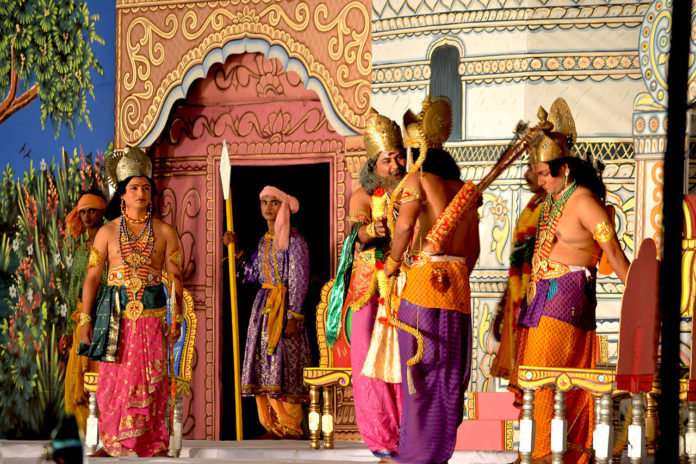Ramlila: The traditional play of the Ramayana

Ramlila – Life of Lord Rama
Ramlila (Rāmlīlā) (literally ‘Rama’s Lila or play’) (रामलीलाः भगवान राम के जन्म की अद्भुत कथा) is a dramatic folk re-enactment of the life of Rama, ending up in the ten-day battle between Rama and Ravana, as described in the Hindu religious epic, the Ramayana. A tradition that originates from the Indian subcontinent, the play is staged annually often over ten or more successive nights, during the auspicious period of ‘Sharad Navratras‘, which marks the commencement of the Autumn festive period, starting with the Dussehra festival.
Usually, the performances are timed to culminate on the festival of Vijayadashami day, which commemorates the victory of Rama over the demon king Ravana, when the actors are taken out in a procession through the city, leading up to a mela ground or town square, where the enactment of the final battle takes place, before giant effigies of Ravana, his brother Kumbhakaran and son Meghanath are set to fire, and coronation or abhisheka of Rama at Ayodhya takes place, marking the culmination of festivities and restoration of the divine order.
Rama is the 7th incarnation of Vishnu and the central figure of the Ramayana. The Ramayana is based on the life, times, and values of Lord Rama. Lord Rama is called the Maryada Purushottam or ‘The best among the dignified‘. The story of Lord Rama and his comrades is so popular in India that it has actually amalgamated the psyche of the Indian mainstream irrespective of their religion. The very story of Ramayana injects ethics into the Indian mainstream.
Most Ramlilas in North India are based on the 16th century Avadhi version of Ramayana, Ramcharitmanas, written by Gosvami Tulsidas entirely in verse, thus used as dialogues in most traditional versions, where open-air productions are staged by local Ramlila committees, ‘Samitis‘, and funded entirely by the local population, the audience. It is close to the similar form of folk theatre, Rasa Lila, which depicts the life of Krishna, popular in Uttar Pradesh, especially Braja regions of Mathura, Vrindavan, and amongst followers of Gaudiya Vaishnavism and Vaishnavism in Manipur, with some similarities with Pandav Lila of Garhwal, based on the life of Pandavas of Mahabharat and Yakshagana of Karnataka, based on various epic and Puranas.
Ramlila has received considerable global attention, especially due to its diverse representation throughout the globe, especially amongst the Indian diaspora community, and regions where Hinduism has spread over the centuries, like Africa and several southeast Asian countries.
UNESCO proclaimed the tradition of Ramlila a Masterpiece of the Oral and Intangible Heritage of Humanity in 2005. Subsequently, Govt. of India and IGNCA produced a two-hour documentary, titled “Ramlila – The traditional performance of Ramayana” for UNESCO, on ‘Ramnagar Ramlila‘, and Ramlila traditions of Avadh, Braj and Madhubani, and that of Ayodhya, which assimilates elements of all three.
Another unique Ramlila is being staged since 1972, at Bakshi Ka Talab, about 20 km from Lucknow, where lead characters like Rama, Lakshman, and Hanuman are played by Muslim youths, a clear departure in a region known for communal flare-ups; this four-day Ram Lila starts on the day of Dusshera day, and has also been adapted into a radio play, ‘Us Gaon ki Ram Lila’, by Lucknow All India Radio, which won the Communal Harmony Award in 2000.
